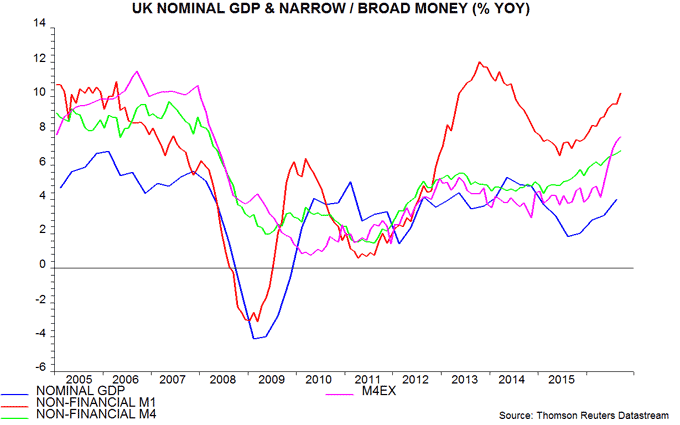UK nominal GDP accelerating in line with "monetarist" prediction
Annual growth of UK nominal (current-price) GDP increased further to 4.0% in the third quarter, according to preliminary ONS data, with monetary trends suggesting a further pick-up into early 2017, at least. The latest OBR Economic and fiscal outlook, for comparison, forecasts nominal GDP growth of only 2.8% in 2017.
Nominal GDP growth has risen since the third quarter of 2015, following increases in annual rates of change of narrow and broad money – as measured by non-financial M1 / M4 – from June and February 2015 respectively. Growth of both money measures continued to climb into September, with broad money expansion the fastest since 2008 – see chart. (October monetary data will be released on 29 November.)
Quarterly growth of constant-price GDP was left unrevised at 0.5% in the third quarter, against a suggestion here of an upgrade – see previous post. As expected on the basis of turnover data, services output rose further in September but the increase was moderated by a fall in financial services activities (not covered by the turnover survey), while July output was revised lower. The implied level of GDP in September, however, is 0.2% above the third-quarter average, creating a solid base for current-quarter growth.
The expenditure details show a 0.9% increase in business investment last quarter, consistent with resilient corporate narrow money trends. Consumer spending continued to drive overall expansion, rising by 0.7%. The ONS headlines refer to net trade adding 0.7 percentage points to quarterly growth but this is misleading: the improvement was entirely due to the balance of trade in non-monetary gold swinging from a deficit in the second quarter to a surplus in the third quarter, i.e. UK residents were net buyers of gold in the second quarter but sold in the third, perhaps partly reflecting profit-taking following sterling weakness. Adjusting for transactions in gold and other valuables, domestic demand contributed to 0.7 pp to third-quarter growth, with net trade subtracting 0.2 pp.

Reader Comments